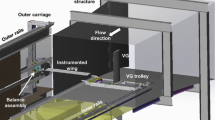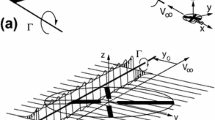Abstract
This contribution relates to the simulation of the flow around the tip of a helicopter rotor blade in hovering flight conditions. We here propose a new methodology of framework adaptation, using a comprehensive rotor code and high-fidelity numerical simulations. We construct an equivalent fixed-wing configuration from a rotating blade, in which centrifugal and Coriolis forces are neglected. The effect of this approximation on the solution is analyzed. The method is validated by a detailed comparison with wind tunnel data from the literature, concerning aerodynamic properties and tip vortex roll-up. This validation also includes variations of the pitch angle and rotational speed, up to transonic tip velocities. Compared to previously published methods of framework adaptation, the new hybrid method is found to reproduce more accurately the flow around a rotating-blade tip.
























Similar content being viewed by others
Abbreviations
- (r, θ, z):
-
Rotating-blade frame
- (x, y, z):
-
Fixed-wing frame
- (X, Y, Z):
-
Inertial frame
- (δ, n):
-
Sectional frame
- (ξ, η, ζ):
-
Non-inertial frame
- c :
-
Blade chord (m)
- C n :
-
Lift coefficient
- C p :
-
Pressure coefficient
- C t :
-
Thrust coefficient
- M :
-
Mach number
- R :
-
Blade radius (m)
- Ro :
-
Rossby number
- V i :
-
Induced velocity m s−1
- V tip :
-
Tip speed (m s−1)
- ρ :
-
Fluid density (kg m−3)
- ψ :
-
Wake age (°)
- ψ S :
-
Segregation wake age (°)
- Ω:
-
Rotational speed (rpm)
- CT:
-
Caradonna and Tung [1]
- KT:
-
Kocurek and Tangler [2]
- K:
-
Komerath et al. [3]
- S:
-
Srinivasan and McCroskey [4]
References
Caradonna, F.X., Tung, C.: Experimental and analytical studies of a model helicopter rotor in hover, NASA TM-81232 (1981)
Kocurek, J.D., Tangler, J.L.: A prescribed wake lifting surface hover performance analysis. J Am Helicopter Soc 22(1), 24–35 (1977). doi:10.4050/JAHS.22.24
Komerath, N.M., Liou, S.-G., Hyun, J.-S.: Flowfield of a swept blade tip at high pitch angles. In: 29th Aerospace Sciences Meeting (1991). doi:10.2514/6.1991-704
Srinivasan, G.R., McCroskey, W.J.: Navier-stokes calculations of hovering rotor flowfields. J Aircr 25(10), 865–874 (1988). doi:10.2514/3.45673
Caradonna, F.X.: The application of CFD to rotary wing flow problems, NASA TM-102803 (1992)
Kamkar, S.J., Jameson, A., Wissink, A.M., Sankaran, V.: Automated off-body cartesian mesh adaptation for rotorcraft simulations. In: 49th Aerospace Sciences Meeting, 17298–17322 (2011). doi:10.2514/6.2011-1269
Rumsey, C.L., Gatski, T.B., Morrison, J.H.: Turbulence model predictions of strongly curved flow in a U-duct. AIAA J 38(8), 1394–1402 (2000). doi:10.2514/2.1115
Spalart, P.R., Shur, M.: On the sensitization of turbulence models to rotation and curvature. Aerosp Sci Technol 1(5), 297–302 (1997). doi:10.1016/S1270-9638(97)90051-1
Komerath, N., Smith, M.J.: Rotorcraft wake modeling: past, present and future. In: 35th European Rotorcraft Forum, 1–26 (2009). ISBN: 9781615678747
Srinivasan, G.R., Raghavan, V., Duque, E.P.N., McCroskey, W.J.: Flowfield analysis of modern helicopter rotors in hover by Navier–Stokes method. J Am Helicopter Soc 38(3), 1–11 (1993). doi:10.4050/JAHS.38.3
Strawn, R.C., Djomehri, M.J.: Computational modeling of hovering rotor and wake aerodynamics. J Aircr 39(5), 786–793 (2002). doi:10.2514/2.3024
Lorber, P.F., Stauter, R.C., Landgrebe, A.J.: A comprehensive hover test of the airloads and airflow of an extensively instrumented model helicopter rotor. In: American Helicopter Society 45th Annual Forum, 281–295 (1989)
Potsdam, M., Yeo, H., Johnson, W.: Rotor airloads prediction using loose aerodynamic/structural coupling. J Aircr 43(3), 732–742 (2006). doi:10.2514/1.14006
Caradonna, F.X., Desopper, A., Tung, C.: Finite difference modeling of rotor flows including wake effects. J Am Helicopter Soc 29(2), 26–33 (1984). doi:10.4050/JAHS.29.26
Egolf, T.A., Sparks, S.P.: A full potential flow analysis with realistic wake influence for helicopter rotor airload prediction, NASA CR-4007 (1987)
Gray, R.B., McMahon, H.M., Shenoy, K.R., Hammer, M.L.: Surface pressure measurements at two tips of a model helicopter rotor in hover, NASA CR-3281 (1980)
Khanna, H., Baeder, J.D.: Coupled free-wake/CFD solutions for rotors in hover using a field velocity approach. In: American Helicopter Society 52nd Annual Forum, 475–487 (1996). ISBN: 9781617829413
Moulton, M.A., Ramachandran, K., Hafez, M.M., Caradonna, F.X. The development of a hybrid CFD method for the prediction of hover performance. In: American Helicopter Society 2nd Specialists’ Conference on Aeromechanics (1995)
Bhagwat, M., Moulton, M.A. and Caradonna, F.X.: Hybrid CFD for rotor hover performance prediction. In: 24th Applied Aerodynamics Conference (2006). doi:10.2514/6.2006-3474
Steinhoff, J., Ramachandran, K.: Free-wake analysis of compressible rotor flows. AIAA J 28(3), 426–431 (1990). doi:10.2514/3.10410
Brown, R.E.: Rotor wake modeling for flight dynamic simulation of helicopters. AIAA J 38(1), 57–63 (2000). doi:10.2514/2.922
Whitehouse, G.R., Tadghighi, H.: Investigation of hybrid grid-based computational fluid dynamics methods for rotorcraft flow analysis. J Am Helicopter Soc 56(3), 1–10 (2011). doi:10.4050/jahs.56.032004
Steinhoff, J., Underhill, D.: Modification of the euler equations for “vorticity confinement”: application to the computation of interacting vortex rings. Phys Fluids 6(8), 2738–2744 (1994). doi:10.1063/1.868164
Tsukahara, T., Ota, T. and Obukata, M.: Numerical analysis around rotor blade by vortex confinement. In: American Helicopter Society 58th Annual Forum, 1527–1541 (2002). ISBN: 9781617829352
Agarwal, R.K., Deese, J.E.: Euler calculations for flowfield of a helicopter rotor in hover. J Aircr 24(4), 231–238 (1987). doi:10.2514/3.45431
Vion, L., Delattre, G., Falissard, F. and Jacquin, L.: Counter-rotating open rotor (CROR): flow physics and simulation, 20ème Congrès Français de Mécanique (2011). http://hdl.handle.net/2042/46356
Benoit, B., Dequin, A.-M., Kampa, K., von Grünhagen, W., Basset, P.-M., Gimonet, B., HOST, a general helicopter simulation tool for Germany and France. In: American Helicopter Society 56th Annual Forum, 660–681 (2000). ISBN: 9781617829376
Landgrebe, A.J.: The wake geometry of a hovering helicopter rotor and its influence on rotor performance. J Am Helicopter Soc 17(4), 3–15 (1972). doi:10.4050/JAHS.17.3
Cambier, L., Heib, S., Plot, S.: The onera elsA CFD software: input from research and feedback from industry. Mech Ind 14(3), 159–174 (2013). doi:10.1051/meca/2013056
Sides, J. and Boniface, J.C.: Calcul d’Écoulements Autour de Pales de Rotor d’Hélicoptère à Partir de la Résolution des Équations d’Euler Compressibles, AAAF 28ème Colloque d’Aérodynamique Appliquée (1991)
Joulain, A.: Aerodynamic simulations of helicopter main-rotor blade tips, Ph.D. Thesis, Université d’Aix-Marseille (2015)
Menter, F.R.: Improved two-equation k-omega turbulence models for aerodynamic flows, NASA TP-103975 (1992)
Menter, F.R.: Two-equation eddy-viscosity turbulence models for engineering applications. AIAA J 32(8), 1598–1605 (1994). doi:10.2514/3.12149
Jameson, A., Schmidt, W. and Turkel, E.: Numerical solution of the euler equations by finite volume methods using Runge–Kutta time-stepping schemes. In: AIAA 14th Fluid and Plasma Dynamics Conference (1981). doi:10.2514/6.1981-1259
Tennekes, H., Lumley, J.L.: A first course in turbulence. MIT Press, Cambridge (1972). ISBN: 9780262200196
Jeong, J., Hussain, F.: On the identification of a vortex. J Fluid Mech 285, 69–94 (1995). doi:10.1017/S0022112095000462
Acknowledgements
The authors thank Michael Le Bars (IRPHE-CNRS) for discussions on the centrifugal and Coriolis forces.
Author information
Authors and Affiliations
Corresponding author
Additional information
This paper is based on a presentation at the 41st European Rotorcraft Forum, September 1–4, 2015, Munich, Germany.
Rights and permissions
About this article
Cite this article
Joulain, A., Desvigne, D., Alfano, D. et al. Numerical investigation of the vortex roll-up from a helicopter blade tip using a novel fixed-wing adaptation method. CEAS Aeronaut J 8, 245–260 (2017). https://doi.org/10.1007/s13272-016-0234-z
Received:
Revised:
Accepted:
Published:
Issue Date:
DOI: https://doi.org/10.1007/s13272-016-0234-z




